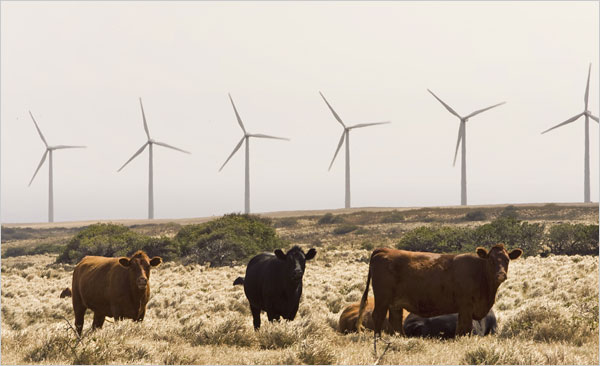
The Big Island of Hawaii gained national attention today in the New York Times. In an article titled Hawaii Tries Green Tools in Remaking Power Grids, author Felicity Barringer focuses on the potential for green energy in Hawaii. The article opens with the mention of a wind farm in Na’alehu (pictured above), located at the south eastern tip of Hawaii. Na’alehu happens to be the home of the Pacific Quest field base. Renewable energy installations such as these are exciting, as they provide evidence that Hawaii is moving toward harnessing green energy.
In January 2008, state governor Linda Lingle created the Hawaii clean energy initiative in response to oil dependence and outrageous electric costs. She hopes to utilize a range of renewable energy sources that we have in this unique location, including wind, sun, land and sea. Drawing on renewable energy resources not only diminishes our ecological footprint, but catalyzes sustainable development.
Right now, imported oil is responsible for producing 77% of Hawaii’s electricity, a figured unparrelled by any other state in the US. Solar power is growing, but still constitutes only 9%. Through agreements reached between the Hawaiian Electric Company and federal government, Hawaii has plans to increase production of renewable energy. If the agreement is upheld, Hawaii will be responsible for generating 40% of its energy through renewable energy technology by 2030.
Should Pacific Quest care about the strive toward utilizing renewable energy? Our dynamic model of therapeutics is heightened by engineering and community planning projects such as these. Through the act of maintaining an organic garden students gain a tangible experience of their connection with the land. When the students sit down to dinner, they eat the salad greens that they grew and nurtured. Energy consumption, while seemingly peripheral, is related. Drawing upon the energy that is created locally, with environmental stewardship in mind, only enhances the connection with the land and others. The emotionally sustainable changes that we incur as individuals is reflected in many ways by our sustainable commitment to our families, communities, and environment at large.
For more pictures of Hawaii’s renewable energy projects visit the New York Times slide show.